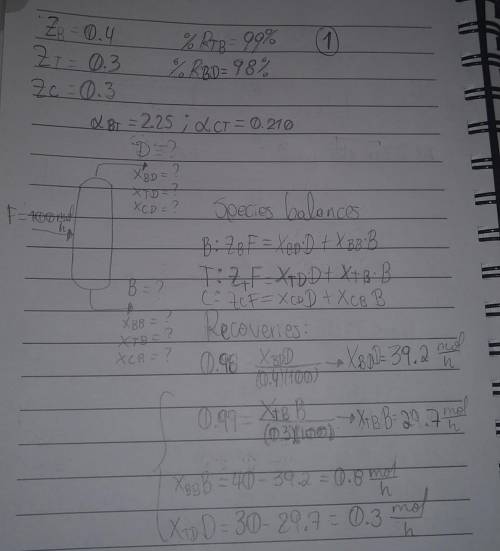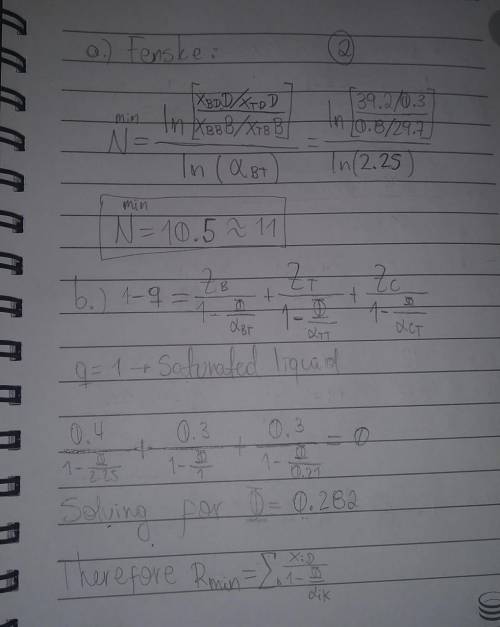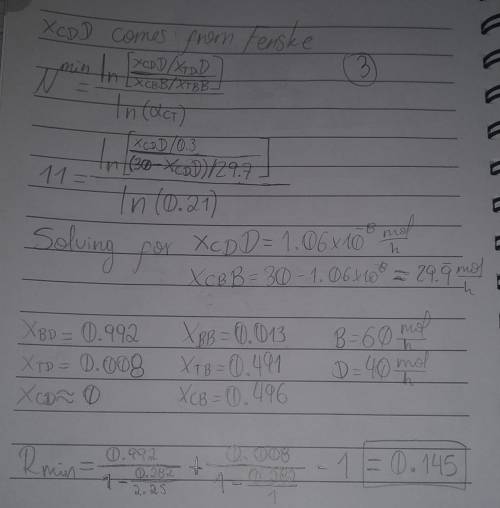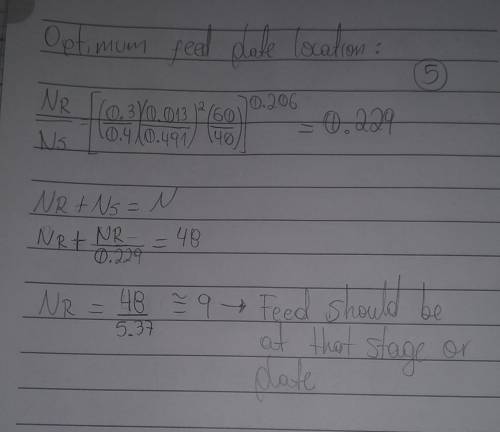
Engineering, 17.03.2020 17:21 iixyloa
A distillation column with a partial reboiler and a total condenser is being used to separate a mixture of benzene, toluene, and cumene. The feed is 40 mol% benzene, 30 mol% toluene and 30 mol% cumene. The feed is input as a saturated vapor. We desire 99% recovery of the toluene in the bottoms and 98% recovery of the benzene in the distillate. The reflux is returned as a saturated liquid, and CMO can be assumed. Equilibrium can be represented as constant relative volatilities. Choosing toluene as the reference component, ?benzene-toluene = 2.25 and ?cumene-toluene = 0.210. Use the Fenske equation to find the number of equilibrium stages required at total reflux and the recovery fraction of cumene in the bottoms. b. For the distillation problem given in part a, find the minimum reflux ratio by use of the Underwood equations. Use a basis of 100 moles of feed/h. Clearly state your assumptions. d. For L/D = 1.25(L/D)min , find the total number of equilibrium stages required for the distillation problem presented in parts a and b. Use the Gilliland correlation. Estimate the optimum feed plate location.

Answers: 3


Another question on Engineering

Engineering, 04.07.2019 18:10
Atmospheric air has a temperature (dry bulb) of 80° f and a wet bulb temperature of 60° f when the barometric pressure is 14.696 psia. determine the specific humidity, grains/lb dry air. a. 11.4 c. 55.8 d. 22.5 b. 44.1
Answers: 1

Engineering, 04.07.2019 18:10
Which of the following controllers anticipates the future from the slope of errors over time? a)-proportional b)-on/off c)-integral d)-derivative.
Answers: 2

Engineering, 04.07.2019 18:10
Water at the rate of 1 kg/s is forced through a tube with a 2.5 cm inner diameter. the inlet water temperature is 15°c, and the outlet water temperature is 50°c. the tube wall temperature is 14°c higher than the local water temperature all along the length of the tube. what is the length of the tube?
Answers: 3

Engineering, 04.07.2019 19:20
At steady state, air at 200 kpa, 325 k, and mass flow rate of 0.5 kg/s enters an insulated duct having differing inlet and exit cross-sectional areas. the inlet cross-sectional area is 6 cm2. at the duct exit, the pressure of the air is 100 kpa and the velocity is 250 m/s. neglecting potential energy effects and modeling air as an 1.008 kj/kg k, determine ideal gas with constant cp = (a) the velocity of the air at the inlet, in m/s. (b) the temperature of the air at the exit, in k. (c) the exit cross-sectional area, in cm2
Answers: 2
You know the right answer?
A distillation column with a partial reboiler and a total condenser is being used to separate a mixt...
Questions

History, 13.04.2021 18:10




French, 13.04.2021 18:10



Social Studies, 13.04.2021 18:10

History, 13.04.2021 18:10





Mathematics, 13.04.2021 18:10





Mathematics, 13.04.2021 18:10

Mathematics, 13.04.2021 18:10








